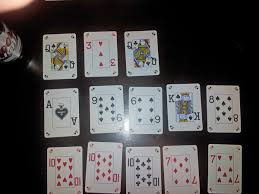
Open-Face Pineapple Texas Hold’em? UK Students Invent New Poker Game

Open-Face Chinese Poker is a popular game among professionals, but may be too complex for many casual players. (Image: Covers.com)
Poker has no shortage of different variants to choose from. Texas Hold’em and Omaha are the standards today, while the classics like Seven-Card Stud and Five-Card Draw are still quite popular as well.
Those looking to be a bit more adventurous can try any number of wacky variations like Five-Card (or Six-Card) Omaha, Badugi, or Razz.
Perhaps the most popular “action” game amongst professional players these days is Open-Face Chinese Poker, a game in which players take turns placing cards to set three hands in an attempt to beat each of their opponents (up to four players can play in a game, as each player gets 13 cards throughout the hand).
The game offers plenty of chances for players to make big scores and offers a high degree of skill while remaining fun for gamblers.
That says, it’s a bit intimidating for players who aren’t familiar with the game, especially when you add in royalty bonuses and fouling rules.
That may be slowing the spread of open-face Chinese poker (OFC), which means that a simpler version of the game could be just what helps drive the masses to this very different form of poker.
Open-Face Hold’em Spreads at Student Tournament
Enter a group of UK students participating in the UK Student Poker Championships. With just a £30 ($44) buy-in, this isn’t the kind of tournament you’d expect to see much reporting on.
But while the students at the side tables in the tournament room started out playing OFC, it didn’t take long before a newly invented game came to dominate the festivities: a game they called Open-Face Pineapple Texas Hold’em.
The game offered a combination of hold’em rules and some aspects of OFC, resulting in a game that was a kind of hybrid between the two. In the game, each player is dealt nine cards.
Three hold’em community card boards are also dealt, with the flops face up but the turn and river cards face down. Assuming a four-player game, this should leave just one card left; this is turned face up and will be the start of the burn pile.
At this point, each player then sets three sets of two hole cards face down, one for each community card board. The three unused cards are discarded face down. Once everyone is finished setting their hands, everyone turns up their hole cards, the turn and river are dealt, and everyone finds out who won each hand.
Scoring is Simpler Than OFCÂ
Unlike in OFC, each board is treated like a regular hand of hold’em: there is only one winner, rather than each player competing against each opponent separately.
Players get one point for winning a hand, or a half-point if they were part of a chop. Winning all three hands results in a sweep, and the winner collects five points per opponent. Royalties are relatively simple: quads are worth five points, a straight flush is worth 20, and a royal flush is worth 50.
This may not be the game that ultimately drives people to OFC: for one thing, the game isn’t really an “open face” game, since players aren’t setting their hands face up.
But the variant is certainly a more accessible game to those who know the rules of hold’em, and it will be interesting to see if the rest of the poker world gives the game a try, potentially ironing out the rules to turn it into another popular way for players to encourage gambling action on the felt.















0 Comments